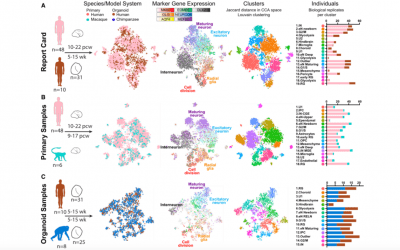Publications
Establishing Cerebral Organoids as Models of Human-Specific Brain Evolution
Summary: Direct comparisons of human and non-human primate brains can reveal molecular pathways underlying remarkable specializations of the human brain. However, chimpanzee tissue is inaccessible during neocortical neurogenesis when differences in brain size first appear. To identify human-specific features of cortical development, we leveraged recent innovations that permit generating…
A non-enzymatic glucose sensor enabled by bioelectronic pH control
Summary: Continuous glucose monitoring from sweat and tears can improve the quality of life of diabetic patients and provide data for more accurate diagnosis and treatment. Current continuous glucose sensors use enzymes with a one-to-two week lifespan, which forces periodic replacement. Metal oxide sensors are an alternative to enzymatic sensors with a longer lifetime…
Human-Specific NOTCH2NL Genes Affect Notch Signaling and Cortical Neurogenesis.
Summary: Genetic changes causing brain size expansion in human evolution have remained elusive. Notch signaling is essential for radial glia stem cell proliferation and is a determinant of neuronal number in the mammalian cortex. We find that three paralogs of human-specific NOTCH2NL are highly expressed in radial glia. Functional analysis reveals that different alleles of NOTCH2NL have varying…
2024
- Yunjeong Park, Sebastian Hernandez, et al. Modulation of neuronal activity in cortical organoids with bioelectronic delivery of ions and neurotransmitters. Cell. vol 4, issue 1, 100686, January 12, 2024 doi: https://doi.org/10.1016/j.crmeth.2023.100686
- Victoria T. Ly, Drew Ehrlich, et al. Gamifying cell culture training: The ‘Seru-Otchi’ experience for undergraduates. Cell. vol 10, issue 9, E30469, doi;
2023
2022
- Sharf, T., van der Molen, T., Glasauer, S.M.K. et al. Functional neuronal circuitry and oscillatory dynamics in human brain organoids. Nat Commun 13, 4403 (2022). https://doi.org/10.1038/s41467-022-32115-4
- Nowakowski TJ, Salama SR. Cerebral Organoids as an Experimental Platform for Human Neurogenomics. Cells. 2022; 11(18):2803. https://doi.org/10.3390/cells11182803
- Schmitz, MT, Sandoval, K, Chen, CP et al. The development and evolution of inhibitory neurons in primate cerebrum. Nature 603, 871–877 (2022). https://doi.org/10.1038/s41586-022-04510-w
- Seiler ST, Mantalas GL, Selberg J, et al. Modular automated microfluidic cell culture platform reduces glycolytic stress in cerebral cortex organoids. Scientific Reports. 2022;12(1). doi:10.1038/s41598-022-20096-9
2021
- Ly VT, Baudin PV, Pansodtee P, et al. Picroscope: Low-cost system for simultaneous longitudinal biological imaging. Communications Biology. 2021;4(1):1261. doi:10.1038/s42003-021-02779-7.
- Baudin PV, Ly VT, Pansodtee P, et al. Low cost cloud based remote microscopy for Biological Sciences. Internet of Things. 2021:100454. doi:10.1016/j.iot.2021.100454.
- Voitiuk K, Geng J, Keefe MG, et al. Light-weight electrophysiology hardware and software platform for cloud-based neural recording experiments. Journal of Neural Engineering. 2021. doi:10.1101/2021.05.18.444685.
- Parks DF, Voitiuk K, Geng J, et al. Internet of things architecture for high throughput biology. bioRxiv. 2021:453595. doi:10.1101/2021.07.29.453595.
- Popova G, Soliman SS, Kim CN, et al. Human microglia states are conserved across experimental models and regulate neural stem cell responses in chimeric organoids. Cell Stem Cell. 2021. doi:10.1016/j.stem.2021.08.015.
- Ziffra RS, Kim CN, Ross JM, et al. Single-cell epigenomics reveals mechanisms of human cortical development. Nature. 2021;598(7879):205-213. doi:10.1038/s41586-021-03209-8.
- Bhaduri A, Sandoval-Espinosa C, Otero-Garcia M, et al. An atlas of cortical arealization identifies dynamic molecular signatures. Nature. 2021;598(7879):200-204. doi:10.1038/s41586-021-03910-8.
2020
2019
- Wu C, Selberg J, Nguyen B, Pansodtee P, Jia M, Dechiraju H, Teodorescu M, Rolandi M. A Microfluidic Ion Sensor Array. Small mall 2020, 16, 1906436.
- Strakosas, X., Selberg, J., Pansodtee, P., Yonas, N., Manapongpun, P., Teodorescu, M., & Rolandi, M. (2019). A non-enzymatic glucose sensor enabled by bioelectronic pH control. Scientific reports, 9(1), 10844.
- Fiddes, I. T., Pollen, A. A., Davis, J. M., & Sikela, J. M. (2019). Paired involvement of human-specific Olduvai domains and NOTCH2NL genes in human brain evolution. Human genetics, 1-7.
- Linsley, J. W., Tripathi, A., Epstein, I., Schmunk, G., Mount, E., Campioni, M., … & Samsi, S. (2019). Automated four-dimensional long term imaging enables single cell tracking within organotypic brain slices to study neurodevelopment and degeneration. Communications biology, 2(1), 155.
- Mayer, S., Chen, J., Velmeshev, D., Mayer, A., Eze, U. C., Bhaduri, A., … & Alvarado, B. (2019). Multimodal Single-Cell Analysis Reveals Physiological Maturation in the Developing Human Neocortex. Neuron, 102(1), 143-158.
- Pollen, A. A., Bhaduri, A., Andrews, M. G., Nowakowski, T. J., Meyerson, O. S., Mostajo-Radji, M. A., … & Fiddes, I. T. (2019). Establishing cerebral organoids as models of human-specific brain evolution. Cell, 176(4), 743-756.
- Pai, E. L. L., Vogt, D., Clemente-Perez, A., McKinsey, G. L., Cho, F. S., Hu, J. S., … & Nowakowski, T. J. (2019). Mafb and c-Maf Have Prenatal Compensatory and Postnatal Antagonistic Roles in Cortical Interneuron Fate and Function. Cell reports, 26(5), 1157-1173.
- Adorjan, I., Tyler, T., Bhaduri, A., Demharter, S., Finszter, C. K., Bako, M., … & Kriegstein, A. R. (2019). Neuroserpin expression during human brain development and in adult brain revealed by immunohistochemistry and single cell RNA sequencing. Journal of anatomy.
- Field, A. R., Jacobs, F. M., Fiddes, I. T., Phillips, A. P., Reyes-Ortiz, A. M., LaMontagne, E., … & Hauessler, M. (2019). Structurally Conserved Primate LncRNAs Are Transiently Expressed during Human Cortical Differentiation and Influence Cell-Type-Specific Genes. Stem cell reports, 12(2), 245-257.
2018
- Fiddes, I. T., Lodewijk, G. A., Mooring, M., Bosworth, C. M., Ewing, A. D., Mantalas, G. L., … & Lorig-Roach, R. (2018). Human-specific NOTCH2NL genes affect Notch signaling and cortical neurogenesis. Cell, 173(6), 1356-1369.
- Mostajo-Radji, M. A., & Pollen, A. A. (2018). Physiological Models of Human Neuronal Development and Disease. Neuron, 100(5), 1025-1027.
- Nowakowski, T. J., Rani, N., Golkaram, M., Zhou, H. R., Alvarado, B., Huch, K., … & Petzold, L. R. (2018). Regulation of cell-type-specific transcriptomes by microRNA networks during human brain development. Nature neuroscience, 21(12), 1784.



